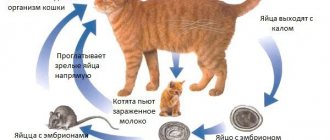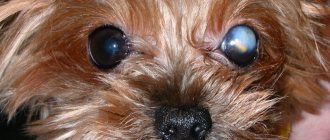Worms, or helminths, is the general name for a variety of parasitic worms found in humans, wild and domestic animals. Helminthiases, or helminthic diseases, even affect plants.
Every third person (perhaps you too) and most wild animals are infected with worms. Pets, including dogs, are also often affected by helminthic infestations. However, it is within our power to understand what the signs of worms are in a dog, how to detect worms and treat them, thereby saving your pet from a whole range of unpleasant diseases.
What to do in such a situation? To get started, we recommend reading this article. This article describes in detail methods of controlling parasites. We also recommend that you consult a specialist. Read the article >>>
Long worms in dogs - types of worms and their classification
Let's discuss what types of worms are there in dogs? All existing worms are divided by taxonomists into three types: these are the type Flatworms, Roundworms and Annelids. Parasites are found in all three types, but the types of worms found in dogs belong mainly to the first two. Annelids neglect predators, except that an occasional leech may sometimes attach itself to a dog passionately loving water.
The most frequent guests in the animal's body are of the type Flatworms. These worms in dogs are flat and flat in appearance, so they are quite easy to identify. They, in turn, are divided into two classes: the class Flukes (or Trematodes) and the class Tapeworms (or Cestodes).
In dogs, worms of the class Tapeworms are found mainly in the intestinal lumen. “Tapeworms” in dogs can reach a considerable length – up to several meters, and live in the dog’s body for 1-2 years.
Another type of “flat” worms in dogs are trematodes, or flukes. These types of worms in dogs are also found in the intestines, but can also be localized in other organs and tissues: liver, gall bladder, and organs of the excretory system. The choice of method for treating dogs for worms in most cases directly depends on the type of helminth and its location.
Another group of types of worms in dogs belongs to the type Roundworms (or Nematodes). Like parasites of other animals, in dogs these worms are round in cross-section, which is what gave the type its name. The most well-known name for this type of worm in dogs is roundworm. Indeed, these are quite common types of worms in dogs, the treatment of which falls on the shoulders of the owner.
Intestinal worms
Most often, dogs and puppies have toxacara, which can be seen in the photo. Their larva emerges from the swallowed egg in the animal’s intestines, then penetrates a blood vessel, through which it enters the lungs and ends up in the oral cavity with a cough. Swallowed a second time, the parasite larva remains in the intestine, where it grows to a sexually mature male or female.
Toxocara
Symptoms of intestinal helminthiasis depend not only on the degree of damage, but also on the age of the dog. Puppies suffer the worst infection from intestinal worms. They almost completely refuse food and begin to lag behind in growth and development. They develop discharge in the eyes and a swollen belly.
All dogs with intestinal parasites experience constipation and diarrhea, pale mucous membranes, problems with appetite, and intestinal colic. In the animal's body, worms can be found at different stages of development, since the dog is the source of infection and infects itself again and again.
Pulmonary parasites
The crenosis nematode, which can infect dogs, is quite rare, since in order to become infected the animal must eat a terrestrial mollusk, which is almost impossible to find on city streets.
However, you still need to know the symptoms of the disease just in case. When acquiring a pulmonary parasite, an animal may experience the following symptoms:
- persistent cough;
- runny nose and sneezing;
- bronchitis;
- deterioration of coat condition;
- progressive emaciation;
- anemia.
It is impossible to cure cough and bronchitis with symptomatic medications and antibiotics.
Liver helminths
Along with raw fish, a dog can eat opisthorchiasis or fluke, which will parasitize the bile ducts of the liver. A sick pet loses weight, and its fur becomes disheveled and dull. If the disease is not treated, fluid accumulates in the abdominal cavity, and the liver becomes painful and enlarged upon palpation.
Opisthorchiasis
Heart parasites
This type of worm deserves special attention, since such an invasion is quite difficult. Infection occurs through a mosquito bite, which injects the helminth into the animal's blood. As a result, a vector-borne disease develops - dirofilariasis.
Dirofilariasis
Developing in the blood vessels and right atrium, mature worms clog them, which inevitably leads to the death of the animal.
Signs of a heart parasite in a dog:
- dry debilitating cough;
- labored breathing;
- dyspnea;
- arrhythmia, slow pulse, swelling and other signs of heart failure;
- general weakness;
- pica;
- convulsions;
- exhaustion.
Parasites that live in the hearts of dogs can be transmitted to humans. However, in our body they do not ripen to a sexually mature state, but this is still not very pleasant.
Routes of infection
Many are convinced that proper care of their pet protects them from infection with worms. And owners of lap dogs who do not go outside believe that they cannot have parasites. But in reality, any pet can become infected. After all, worm eggs are everywhere. They are on the ground, plants, water and even air. The larvae enter the animal's body through raw meat or fish, or from human shoes.
These parasites are very tenacious and adapt to any conditions. Eggs outside the host’s body can remain on objects and the ground for up to 6 months. Their carriers can be cattle, fish, fleas, and mosquitoes.
The main routes of infection by worms are:
- oral – through the animal’s mouth;
- transmissible - when bitten by blood-sucking insects;
- intrauterine – to puppies from a sick bitch.
A pet can become infected by swimming in a pond, playing in the grass with a stick or ball, or interacting with infected animals.
White thin and long worms in a dog
This group of parasites is also called roundworms. The worms received this name due to their round shape in the lateral projection when viewed in a cross section. The body of nematodes has long pointed ends.
The most common representatives of the species are human roundworm, trichinella, whipworm and pinworms. Here you should figure out what worms look like.
- Human roundworm – the helminth looks like a spindle. The body size of females can reach up to half a meter, males - 2 times less. The parasite is able to move throughout the gastrointestinal tract, entering the lungs, liver, and oral cavity. In human feces you can find worm eggs or a mature individual, yellow-red in color, whose body reaches 40 cm in length.
- The whipworm is a small helminth whose body is white. Since the worm has the peculiarity of parasitizing in the rectum, the female’s eggs come out with feces. Can be found in a child's stool.
- Trichinella is a worm up to 0.5 cm in size. A mature individual can enter the bloodstream and spread throughout the body. It is difficult to say what worms look like in feces, since they do not lay eggs (viviparous parasites), they themselves encapsulate and die in the host’s body within several years.
- Pinworms are thin worms that are gray-white in color. Their size reaches 1 cm in length. Females lay eggs in the anus, so it is not uncommon to find a thin, whitish parasite in a child's potty. The worm looks like a light, thin, crawling worm in feces. In this case, we can talk about the development of enterobiasis.
Features of tapeworms
These worms belong to the group of flatworms. Unlike nematodes, their larvae tend to multiply in the body of fish or animals, and then enter the human gastrointestinal tract. The presence of parasites in the stool or their eggs indicates the development of the disease. Here you should figure out what worms look like in feces.
The first representative of the species is the wide tapeworm . This helminth is one of the largest worms. Its length can reach 20 meters. It enters the human gastrointestinal tract with fish eggs or fillets.
Wide tapeworm
Every day, a sexually mature individual excretes several million eggs in the feces. What do worm eggs look like? They are yellow-brown in color and oval in shape. There is a tubercle at one end of the egg and a cap at the other.
The liver fluke is the next representative of the class. This parasite is considered the causative agent of fascioliasis and opisthorchiasis. In humans, helminth eggs can be detected in human stool only a few months after infection. They are oval in shape, quite large compared to other worms, and have a cap at the end.
Trematodes and features of their type
Here we will look at flukes-worms, what they look like and what harm their parasitism can cause to the human body.
The class of trematode helminths includes more than 3 thousand species of individuals. Their vital activity occurs due to spines, suction cups and other formations on the surface of the body that allow them to move. The body of representatives of flukes resembles a leaf, that is, it is a flat ribbon, up to 8 cm in length.
The main representatives of helminths of this group are considered to be the Siberian fluke (feline fluke), lanceolate fluke and pulmonary fluke. What do worm flukes look like? Worms can be found in the stool of adults and children in the form of small white worms.
Cat fluke
In fact, these are segments that break off from the helminths and are brought out. Eggs of tape parasites can also be found in human stool. However, their sizes are so small that they can only be seen under a microscope when examining feces.
Visually, all representatives of trematode worms in feces are similar to each other. Differential diagnostics will be carried out by a laboratory doctor.
Diagnostics
It is often impossible to detect helminthiasis without examination, since the symptoms are vague. It is imperative to conduct an analysis to make a correct diagnosis. Worms are usually found in the feces of dogs, and sometimes blood, urine, and sputum tests are taken.
The doctor will examine the animal and ask the owner about the symptoms. But tests are decisive for making a diagnosis. Sometimes you have to take them again.
What do worms look like in dogs: photos and signs
All helminths that parasitize the dog’s body are divided into three groups: cestodes, nematodes and trematodes. Let's look at each of them in more detail. So, next are worms in dogs: photos with names.
This species belongs to the type of flat (tape) worms. Their flattened body consists of many segments. The length of such worms reaches 10 meters, but there are also small parasites whose size does not exceed 1 cm.
Adults have hooks on their heads for attachment to organs. These representatives of cestodes are most common: bovine and pork tapeworms, echinococcus, broad tapeworm.
This species includes roundworms.
Nematodes most often affect the dog's body.
The body is round in cross-section, reaches a length of 8 meters, non-segmented. Worms are covered with a cuticle (ringed or smooth).
The digestive system is tube-shaped. Prominent representatives of nematodes: roundworms, trichinella.
Such worms are called flukes. Characteristic features include the presence of suckers in helminths (one is located at the front end of the parasite, the other in the middle). The body is shaped like a flat leaf.
Some representatives reach a length of 1.5 meters, but only small flukes, not exceeding a few mm, live in the body of dogs.
Worm eggs in dogs
Helminth eggs are very small, so they can only be seen through a microscope. Each group of parasites has its own appearance of eggs:
- roundworms. They lay unfertilized and fertilized eggs. Externally, they are similar: they have an oval shape and are painted dark yellow. The surface is slightly bumpy. A germ cell is visible in fertilized eggs.
- tapeworms. They lay large oval and slightly rounded eggs. Due to their large size, they are easy to detect in feces.
To detect helminth eggs, you need to submit your dog's feces to a laboratory.
How to treat helminthiasis in dogs
Fortunately, today there is no problem with how to treat helminthiasis in dogs. Pharmaceutical companies produce hundreds of types of drugs that allow them to quickly and reliably cope with diseases of a parasitic nature.
Important! I would immediately like to warn dog breeders against prescribing medications on their own: first, it would be a good idea to accurately determine the species of parasites, and only then, with the help of a veterinarian, prescribe a truly suitable drug.
Otherwise, it may easily turn out that the medicine used is not very effective, and the animal’s liver and kidneys only receive extra stress. This is especially important in the case of young puppies and old dogs, whose bodies are much more sensitive to the components of antiparasitic drugs.
Since independently determining the species can be very difficult, we advise you to immediately contact your veterinarian.
Common medications for treating white worms
The most commonly used drugs are:
- Pyrantel and all its derivatives are very effective against almost all types of parasitic roundworms.
- With cestodes, everything is somewhat more complicated, since these parasites are more difficult to completely destroy. To treat animals with cestodias in veterinary medicine, the aid compounds praziquantel, epsiprantel, and fenbendazole are actively used. The most common drugs are based on praziquantel and fenbendazole, but practicing veterinarians advise the use of epsiprantel derivatives. The fact is that they are not only highly effective, but also practically safe for the animals themselves, even with a fairly strong overdose.
However, in many cases there is no need to take a special look at the composition of medicines: most of the products produced by the modern pharmaceutical industry are equally effective against both round and flatworms.
As for trematodes, the same derivatives of praziquantel, epsiprantel and fenbendazole are used to treat the diseases they cause.
How to detect an infestation
Heartworms are very common and any dog can become infected. Therefore, every owner needs to know how to determine that a pet is sick. This will help you start treatment on time and prevent complications.
The difficulty is that many manifestations of helminthiasis are mild and resemble signs of other diseases, for example, poisoning or a cold. But there are several symptoms that require your dog to be seen by a veterinarian as soon as possible:
- changes in appetite, unnatural eating habits;
- hiccups, difficulty swallowing;
- itching of the anus, which manifests itself in the fact that the dog will ride on the floor on its butt;
- nausea, frequent vomiting, alternating constipation and diarrhea;
- the animal becomes lethargic, constantly lies down, does not want to play;
- the fur is tousled, dull, dandruff and bald patches may appear;
- feces with mucus, blood, sometimes you can notice worms or their larvae;
- the stomach is hard and swollen, although the pet looks thin;
- mucous membranes are pale;
- vitamin deficiency and anemia develop;
- allergic reactions;
- The pet's immunity decreases and he often gets sick.
If parasites have settled in a puppy, he will lag behind in development, grow poorly, and refuse food. He clearly has a bloated abdomen and discharge from his eyes and nose.
Prevention measures
Among such measures are:
- Carrying out deworming of the female dog before mating to prevent infection with helminths from the partner.
- Two weeks after the birth of puppies, preventive treatment is carried out.
- Walk dogs only in designated areas.
- You should not allow your dog to eat food picked up on the street.
- Drinking water must be clean.
- Regularly exterminate fleas.
- It is not recommended to feed animals raw food, meat, fish.
If you follow simple precautions, your pet will be healthy and playful, and you will not have to worry about your future canine offspring. You will protect yourself from the possibility of becoming infected with worms from your dog.
Personal safety measures
Medicines for the destruction of worms contain a small concentration of poison or a paralyzing substance for parasites. Therefore, during deworming, observe personal safety measures. After handling any form of medication, wash your hands with soap and discard the product packaging.
Keep deworming medications out of the reach of children and animals. Do not use medicine that has expired or after darkening, cloudiness, or impurities have appeared. Do not use empty bottles for household purposes.
It is possible to defeat parasites!
Antiparasitic Complex® - Reliable and safe removal of parasites in 21 days!
- The composition includes only natural ingredients;
- Does not cause side effects;
- Absolutely safe;
- Protects the liver, heart, lungs, stomach, skin from parasites;
- Removes waste products of parasites from the body.
- Effectively destroys most types of helminths in 21 days.
There is now a preferential program for free packaging. Read expert opinion.
Read further:
What do worm larvae look like: round and tapeworms, flukes
What worms look like in children: roundworms, pinworms, flukes and tapeworms
Long worms in cats: main types, description and methods of treating parasites in cats
Tapeworms in cats and dogs: symptoms, signs, medications and treatment tablets
Drops on the withers against worms for dogs: a list of the most effective drugs with descriptions
What color are worms in an adult, a child, a cat or a dog?
Danger to humans
A dog or puppy with worms, when interacting with a person, can infect him with helminthiasis. The larvae and eggs of parasites leave the animal's body in the feces. They can attach to the pet's fur, bedding or toys, and then end up in the owner's hands.
Due to the difference in body temperature, not all dog worms can live in the human body. But some of them can cause dangerous diseases.
- Toxocara canis. The larvae migrate through the human circulatory system, settling in various organs. As a result, ocular or visceral toxocariasis develops. It affects the lungs, liver, eyes, and central nervous system.
- Echinococcus granulosus. The larvae of this helminth are extremely dangerous for the human body, although they cannot develop in it. They migrate throughout the body and settle in the lungs, forming a cyst. The neoplasm causes coughing and chest pain.
- Echinococcus multilocularis. The larvae of this tapeworm settle in the human liver and also form a cyst. When a secondary infection occurs, jaundice, abscess, and cirrhosis of the liver develop.
- Coenurus cerebralis. The larvae of such worms look like a water bubble. They settle in the area of the spinal cord or brain. Depending on the location of the lesion, a person suffers from migraines, seizures, and decreased vision.
- Dipylidium caninum. The tapeworm takes root in the human intestine, develops, grows, and reproduces. As a result, the patient suffers from diarrhea, skin rash, and abdominal pain.
Timely deworming and proper personal hygiene will help avoid the development of these diseases.











